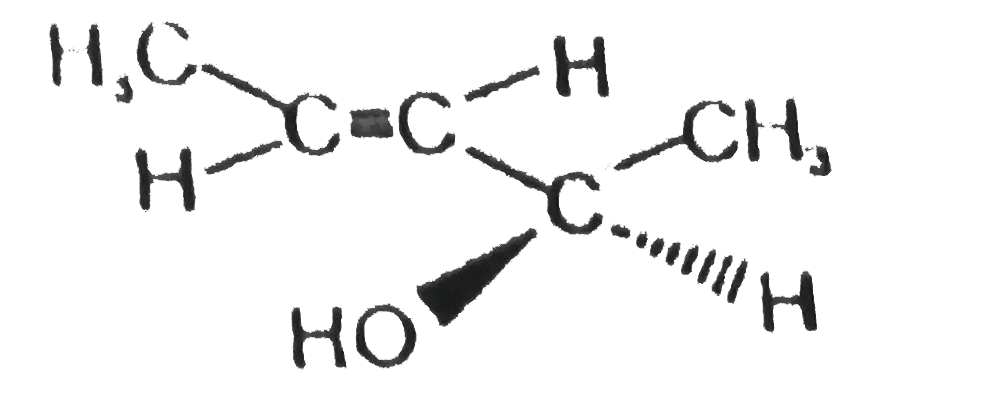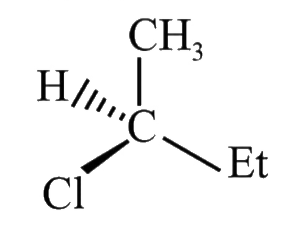Enantiomers have: -
all physical properties same except their action on plane polarized
light which is equal in magnitude but opposite in direction.
all chemical properties same except when reagent is chiral in that
case, reactivity of enantiomer will be different
opposite configuration of all chiral centers according to CIP rule.
superimposable image of each other
The correct Answer is:A, C
To answer the question "Enantiomers have:", we will evaluate the statements provided and determine which ones are correct regarding the properties of enantiomers.
1. Understanding Enantiomers:
Enantiomers are a type of stereoisomer that are non-superimposable mirror images of each other. They typically arise when a molecule has one or more chiral centers.
Hint: Remember that enantiomers are related like left and right hands; they cannot be perfectly aligned even though they are similar.
2. Statement Evaluation:
- Statement 1: "All physical properties same except their action on the plane polarized light which is equal in magnitude but opposite in direction."
- This statement is correct. Enantiomers have identical physical properties (like boiling point, melting point, etc.) except for their optical activity. They rotate plane-polarized light in opposite directions (one clockwise and the other counterclockwise).
Hint: Focus on the concept of optical activity and how it differentiates enantiomers.
- Statement 2: "All chemical properties same except when reagent is chiral, reactivity of enantiomer."
- This statement is also correct. Enantiomers behave identically in reactions with achiral reagents, but they can react differently with chiral reagents because the spatial arrangement of atoms affects the interaction.
Hint: Consider how chiral environments can lead to different outcomes in reactions involving enantiomers.
- Statement 3: "Opposite configuration of all chiral centers according to CIP rule."
- This statement is correct. Enantiomers have opposite configurations at all chiral centers, which can be determined using the Cahn-Ingold-Prelog (CIP) priority rules.
Hint: Recall the CIP rules for assigning priorities to groups attached to chiral centers.
- Statement 4: "Superimposable image of each other."
- This statement is incorrect. Enantiomers are non-superimposable mirror images, meaning they cannot be aligned perfectly like two identical objects.
Hint: Visualize how two enantiomers would look in a mirror; they will always differ in orientation.
3. Conclusion:
Based on the evaluation of the statements:
- Statements 1, 2, and 3 are correct.
- Statement 4 is incorrect.
Final Answer:
Enantiomers have the following properties:
- All physical properties same except their action on the plane polarized light which is equal in magnitude but opposite in direction.
- All chemical properties same except when reagent is chiral, reactivity of enantiomer.
- Opposite configuration of all chiral centers according to CIP rule.
- They are not superimposable images of each other.
Enantiomers are a type of stereoisomer that are non-superimposable mirror images of each other. They typically arise when a molecule has one or more chiral centers.
- Statement 1: "All physical properties same except their action on the plane polarized light which is equal in magnitude but opposite in direction."
- This statement is correct. Enantiomers have identical physical properties (like boiling point, melting point, etc.) except for their optical activity. They rotate plane-polarized light in opposite directions (one clockwise and the other counterclockwise).
Hint: Focus on the concept of optical activity and how it differentiates enantiomers.
- This statement is also correct. Enantiomers behave identically in reactions with achiral reagents, but they can react differently with chiral reagents because the spatial arrangement of atoms affects the interaction.
Hint: Consider how chiral environments can lead to different outcomes in reactions involving enantiomers.
- This statement is correct. Enantiomers have opposite configurations at all chiral centers, which can be determined using the Cahn-Ingold-Prelog (CIP) priority rules.
Hint: Recall the CIP rules for assigning priorities to groups attached to chiral centers.
- This statement is incorrect. Enantiomers are non-superimposable mirror images, meaning they cannot be aligned perfectly like two identical objects.
Hint: Visualize how two enantiomers would look in a mirror; they will always differ in orientation.
Based on the evaluation of the statements:
- Statements 1, 2, and 3 are correct.
- Statement 4 is incorrect.
Enantiomers have the following properties:
- All physical properties same except their action on the plane polarized light which is equal in magnitude but opposite in direction.
- All chemical properties same except when reagent is chiral, reactivity of enantiomer.
- Opposite configuration of all chiral centers according to CIP rule.
- They are not superimposable images of each other.
Similar Questions
Broadly speaking there are four types of stereisomers namely conformational isomers geometrical isomers, enantiomers and diastereomers.Although conformational isomers , have same configuration geometrical isomers have different atoms attached to each of the doubly bonded carbon atom, and enantiomers are due to chirality in the molecule Enantiomers are also known as optical isomers and diastereomers are those stereoisomers which are not enantiomers.In simple compound, number of stereoisomers.In chiral molecule is given by the reaction 2n, where n is the number of dissimilar chiral carbon.
Observe the following structures and answer the questions given below :

How many stereoisomers are possible in pent-3-en-2-ol, CH3CH=CHCHOHCH3View SolutionEnantiomers may possess different rates of reactions with other optically active compounds.
View Solution
Knowledge Check
- Question 1 - Select One
The number of enantiomers of the compound CH3−CH∣Br−CH∣Br−COOH is
A2B3C4D6 - Question 2 - Select One or More
A pair of enantiomers is:
Aa pair of non superimposable mirror image of each otherBa pair of superimposable image of each otherCalways optically active if one is dextrorotatory then other will be laevorotatory by same magnitudeDcompounds having same boiling points - Question 3 - Select One
(+)-2-butanol has [θ]25γ−+13.9∘. A sample of 2-butanol containing both the enantiomers was found to have a specific rotation value of −3.5∘ under similar condition. The percentage of the (+) and (-) enantiomer present in the sample are, respectively :
A37.4% and 62.6%B62.6% and 37.4%C42.2% and 57.8%D35.5% and 64.5%
How many pairs of enantiomers are possible for [M(AA)(BC)de] ? .
View SolutionWhich of the following is the enantiomer of the structure?
 View Solution
View SolutionR, S-configuration is a useful tool for determination of enantiomers, diastereomers and homomers. If configuration of all chiral centers are opposite then structures are enantiomers, if all chiral centers have same configuration then they are homomers and if some have same configuration and some have opposite configuration then they are diastereomers.

Which of the following is not diastereomer?View SolutionR, S-configuration is a useful tool for determination of enantiomers, diastereomers and homomers. If configuration of all chiral centers are opposite then structures are enantiomers, if all chiral centers have same configuration then they are homomers and if some have same configuration and some have opposite configuration then they are diastereomers.

Which of the following is not diastereomer?View SolutionR, S-configuration is a useful tool for determination of enantiomers, diastereomers and homomers. If configuration of all chiral centers are opposite then structures are enantiomers, if all chiral centers have same configuration then they are homomers and if some have same configuration and some have opposite configuration then they are diastereomers.

Among above structures find out enantiomerie structures :View Solution

